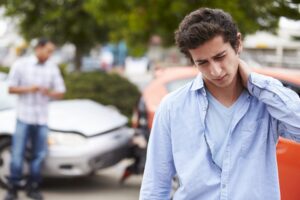
Car Accident Compensation And Child Support
Navigating the aftermath of a car accident can be complex, especially when it comes to financial matters such as child support obligations. If you’re considering
BARNEY INJURY LAW
Over the past several years, autonomous driving technology has developed rapidly. This has created numerous safety questions and concerns.
Will driverless cars make driving safer?
How safe is considered safe enough?
Furthermore, how do we prove driverless cars are safe?
Some people do not want to put their lives in the hands of driverless cars, while others adore the concept.

The driverless car market is valued at $54 billion and expected to grow over 10 times that amount. Regardless of your feelings, driverless cars will soon be everywhere.
Some autonomous cars, such as Tesla’s Model S, have autopilot systems. This system enables the car to estimate distances between other cars, check lanes, and direct the car using radar and sensors. Also, the car has control over its own speed and braking.
Numerous videos surfaced showing the Model S swerving into different lanes. Other videos released showed drivers asleep at the wheel. However, Tesla’s autopilot is only meant to be a driver-assistance system. Since the car is not meant to drive itself, drivers should still pay attention to the road.
Google’s Waymo already started making cars with no steering wheels or pedals. The company plans on making them publicly available by 2020. Waymo’s driverless cars have driven over 10 million miles.
Since 2009, these cars have been involved in approximately two dozen accidents. Only one of those accidents was the driverless car’s fault. Google blamed these crashes on human error rather than technological problems.
It is estimated that more than 90% of car accidents are a result of human error. The rate of computer error is considerably lower than human error.
Research suggests that reducing the number of human drivers would reduce the number of accidents about 80%.
Additionally, accidents that occur will be much less severe.
The key advantage of driverless cars is that computers are programmed to follow all traffic laws.
Unlike human drivers, driverless cars will not speed or get distracted behind the wheel. Driverless cars will never fall asleep or get drunk.
Theoretically, their detection systems work better than human eyes at night and low-light conditions.
Driverless cars contain both sensors and software to create a three-dimensional environment around the car. Radar sensors gage the speed and mass of objects on the road. Additionally, HD cameras can read traffic signals and signs.
The systems of driverless cars are capable of processing thousands of sensory details per second. GPS is automatically cross-referenced to better plan the most efficient route. Computer programs reach instantaneous judgments regarding navigation around cars, humans and animals on the road.
Driverless cars communicate with one another in order to prevent accidents. Driverless cars inform each other of unsafe situations that human drivers might not notice. This allows the driverless car to take evasive actions and avoid accidents.
Driverless vehicles would also lead to there being fewer cars on the roads in general.
Since driverless cars can be called for whenever needed, directed more proficiently and more easily shared, this would reduce single passenger rides.
Reducing the number of cars on the road would further help prevent accidents. Fewer cars on the road would also make more room for cyclists and pedestrians, as well as reduce stress and anxiety levels for human drivers.
As with any new technology, driverless cars have some technical issues. Testing the safety of driverless cars is a challenge in and of itself. The software learns from real driving conditions. This makes real life assessment on public roads vital.
Collecting sufficient data to demonstrate these cars are safe requires driving hundreds of millions of miles. This is extremely expensive.
Moreover, whenever there is a change to the technology, the assessment process needs to start all over again. Where the cars are being tested, based on weather and terrain, makes a huge difference.
Critics argue that the day to day variables and unpredictable factors make it inherently difficult for driverless cars to navigate.
Driverless vehicles are not fully programed to detect or avoid more vulnerable people, such as kids, hitchhikers, construction works, elders, cyclists, or the homeless.
Unforeseen circumstances are likely to cause software glitches or computer malfunctioning.
Driverless cars are supposed to react to situations in ways that would result in the fewest casualties. There are still many unanswered questions regarding how the car determines this.
No computer system is without faults.
In 2018, a driverless Uber car crashed into and killed a woman crossing the street with her bike.
Although the car detected her before striking, the software failed to react in time to prevent the crash. Furthermore, the collision-avoidance system was found disabled.
Another key problem is the lack of regulatory framework.
Regulators are still determining the type of data that they can obtain and examine to assess the safety of driverless cars. Enacting guidelines is essential to having a safety standard.
Safety standards used to be founded on historical crash data. This allowed lawmakers to track years of accidents before any official recommendations. With technology rapidly advancing, time testing every new system is almost impossible.
As technology continues to advance, future cars will learn from the accidents and mistakes of their predecessors.
Many critics have doubts about placing their lives in the hands of driverless cars.
We need to accept that driverless cars are not perfect and some accidents are unavoidable.
In a 2017 experiment, it was determined that the earlier autonomous cars are widely used, the more lives will be saved.
Scientists discovered that using cars that are only 10% safer than human drivers would save more lives than waiting until they are 75% safer.
Thus, although driverless cars are not without fault, more lives will still be saved if their use becomes mainstream.
While driverless cars are not flawless, they are in most circumstances less imperfect and thus still safer than their human counterparts.
Driverless cars will eventually lead to safer and less congested roads, but this is not going to occur overnight. Until driverless cars are perfected, accidents will still take place.
If you have been involved in a car accident, hiring a car accident lawyer is always highly recommended.
We can assist you if you are involved in an automobile accident, including one with a driverless car. In order to recover from a car accident, you may need prolonged time off from work and close medical supervision.
Even if you were partially at fault for the car accident, you may still be able to recover damages.
As the victim of a car accident caused by someone else’s negligence, you may be eligible to receive financial compensation to help recover from your injuries.
The Law Office of Scott R. Barney strives to help our clients get back on their feet after devastating car accidents. We would be honored to serve you. Please call today at (757) 296-7277 or contact us online to discuss your options more in-depth.

Navigating the aftermath of a car accident can be complex, especially when it comes to financial matters such as child support obligations. If you’re considering

Welcome to Barney Injury Law, where our mission is to fight for your rights and secure the compensation you deserve. As your dedicated Personal Injury

Death is always a delicate topic, but when it comes to the heavy burden of being wrongful, it tangles with the legal system in complex

The world of car insurance is constantly evolving, and it’s essential to stay informed about any changes that could impact your coverage. In July 2023,
Personal Injury Lawyer Serving
Virginia Beach Have You Been In An Accident?

VX4F+FJ Virginia Beach, Virginia
